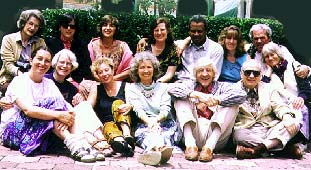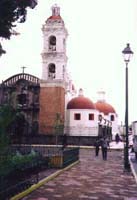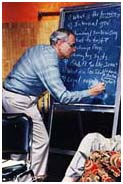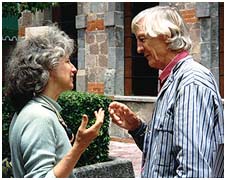on Education: The Report
SICA Workshop
SICA EDUCATION WORKSHOP
Tlascala, Mesico June 28 - July 2, 1999
by Reynold Feldman, Laurie Lathrop and Illene Pevec
Overview:
Some 25 Subud members from Europe, North and South America, and Asia participated in the SICA Education Workshop held the week after the First Subud Pan-American Congress at La Trinidad Vacation Center in Tlaxcala, Mexico. Over a year in planning, the Workshop was organized by Laurie Lathrop, anthropologist and university lecturer from the Washington, DC area. The stated purpose was to identify some successful teaching practices in Subud and Subud-related elementary (K-6) schools, to tease out the components or combination of components that have made these practices successful, and to conceptualize the components so that they can be shared with others.
The Workshop:
The Workshop began Monday morning with a brief talk on education by Ibu Rahayu and ended Friday with a discussion and agreement on Next Steps. The Workshop was facilitated by Reynold Feldman (Honolulu, Hawaii, USA), retired university educator and founder of the World Wisdom Project. Costs were underwritten by the Guerrand-Hermès Foundation for Peace. Highlights included presentations by the Alfragide School, Lisbon, Portugal; the Cita Buana School, Jakarta, Indonesia; Colegio Amor, Bogotá, Colombia; and Escuela Pestalozzi, Tumbaco (near Quito), Ecuador. A presentation on the Nkembo School, Muanda, Democratic Republic of Congo, was omitted when the school's founders were unable to obtain entry visas to Mexico. Halimah Polk also made a Power Point presentation on the four schools represented at the Workshop. Finally, participants did latihan together twice daily and were able to test on the gifts of the presenting schools to their students as well as on their own next steps with regard to education and Subud.
Ibu Rahayu's Talks
Ibu Rahayu, director of the Muhammad Subh Foundation and daughter of the late YM Bapak Mhd. Subuh Sumohadiwidjojo was also asked to comment. She reminded those present that it is through social and cultural activities, including education, that we Subud members connect with the world outside Subud. We are still struggling to understand and implement Bapak's advice on education. Teachers represent their students' parents, who are the primary persons who raise and guide children. If we are Subud members whose talent it is to teach and who in fact are educators, what we give our students will go beyond the simple transfer of information and skills. Through our actions and example, we will provide them with "something that is alive" and will have a positive impact on our working environment. For this reason, we should simply follow the curriculum that is normal in our cultural context and not speak of being "a Subud school," lest parents suspect that our school is "something weird." From a legal point of view, schools are "Subud schools" only if they are controlled by a foundation or enterprise run by Subud members. Such organizations have the right to employ Subud members who are professional teachers. With inner feelings that are alive, Subud teachers will not work like machines but will be able to know the talents of their students and will thus be able to get close to them.
Children nowadays, she added, tend to be impatient and bored with school. The challenge for Subud teachers is how to motivate and encourage them so they do not drop out but learn what they need to know. Through schools we can educate people to become human beings of noble character. Enterprises should help fund schools to do this work. Schools should not "get stuck half way" in this process for lack of funds.
Ibu Rahayu's closing thought was a hope that our work might become an example to people outside Subud. Full text of this talk is available on the Subud Portal.
School Reports:
The first two days of the education conference were devoted to presentations by the schools in attendance: Pestalozzi started by Mauricio and Rebeca Wild and run collaboratively by working teams in Ecuador, Colegio Amor run by Mónica Ramírez in Bogota with a new branch soon opening in Amanecer, Alfragide in Lisbon, Portugal, run by Irina Mendes and Daniela Margarido, and Cita Buana School located in Bapak's house in Wisma Subud and represented by Ismana and Haryono Sumohadiwidjojo and Wayne Lerrigo from the Board. Inca Semana in Ecuador and the Nkembo school in the Congo were unable to attend this workshop.
THE PESTALOZZI SCHOOL
:The Pestalozzi School in Tumbaco (half an hour's drive from Quito) began in 1977 as a Montessori preschool with three students when the Wilds decided to create a good environment for their second son's development. Their despair about the effects of regular school on their first son gave them the courage to continue into the primary (1979) and later secondary level (1986) in order to save their second son from going through the same experience. To guarantee the nonprofit character of the school, in 1982 it was legally established as a foundation. In 1989 "Pesta" gained official government recognition as giving "Basic Ecuadorian education for nine years without grades." Since the school has no grades, formal classes, examinations or marks, a detailed description of the developmental process of each child gives the basis for all certificates awarded. For many years the school has had an enrollment of around 190 children ages three to 18 from different social backgrounds. There are 15 adults responsible for the students' environment, and 16 more staff for related activities (including a carpentry shop and the creation of an university where students will be responsible for teaching themselves).
The goal of the school is to respect life processes. For the Wilds this means that interaction has to take place from the inside out and not through stimulation, motivation or even subtle guidance from the outside. Children, like all living organisms, come to this world able to differentiate what is outside themselves and to value and choose what they need in order to grow and develop according to their true nature and inner plan. Since a child has a basic need for love, he or she can easily be conditioned if this love is given with the intention to influence them "for their own good." If, however it is given with respect and without conditions and if the environment contains everything that satisfies their authentic needs, then children can interact without losing contact with their inner natures, and thus their emotional, social and cognitive development will take place in harmony.
For this reason at the Pestalozzi adults don't teach, but instead are constantly taking care of the environment (to which they also belong), making sure that it stays relaxed so that children don't have to defend themselves or fight for their integrity. This situation implies that the adults want to learn to relate to the children in a loving but non-directive way, that they have at least some basic understanding about children's developmental needs and are interested in what happens, that limits and rules are clear, that everything the children may need for their development is available and that they are free to choose from this wide range of resources. Many of the presuppositions on which the Pestalozzi is based find an important foundation in neurobiological studies, for instance the conviction that the development of inner structures of understanding is built through personal interaction with the world, that the heart is the decision-making instrument of the body, and that--like all other bodily functions--the connection between the heart and the brain can only develop through the constant exercise of decision-making from early on.
Children and adolescents interact with the environment individually, in spontaneous interest groups and especially as adolescents in voluntary work groups accompanied by adults, with these groups becoming more and more important as the children grow older. If they wish, from age ten the children begin to work in community businesses and all sorts of artistic and practical activities. This gives them the chance to explore a wide range of concrete situations through personal experience. From age seven on, children and adolescents participate actively in the creation of the rules that allow for the good functioning of the environment and guarantee mutual respect. The Wilds believe that real understanding grows only through self-directed, voluntary interaction and that knowledge without understanding is dangerous for both individuals and the world they transform to fit their needs and desires.
The slides the Wilds presented showed an aesthetically beautiful environment close to nature, enriched with a wide range of materials (many made in the school's carpentry shop) for play, sports, practical and artistic activities. There were also a big math lab with many concrete manerials as well as a library and studios for language and all the other "subjects" normally taught in school. In order to be fully present in this environment in a non-directive way, to learn to understand processes of development and enhance the environment, practice with materials and cooperate with each other in a responsible and flexible manner, the teachers meet four afternoons a week for two hours each. Cooperation between home and school is made possible through regular parents meetings and family counseling. At the weekly barter market people gather informally in a relaxed atmosphere. Here the adults have ample opportunity to exchange experiences. A highlight of the Pestalozzi presentation was an inspiring video prepared by a student about the school's 6000-kilomenter bike trip which 38 students and eight adults made from Ecuador over the Andes through Colombia and Venezuela to Manaus in the heart of the Brazilian Amazon. The students were thirteen to 18 years old, and except for one girl who suffered broken ankles when a truck hit her bike and had to be flown home, all the other students completed the trip safely. Rebeca Wild's first book, An Education for Being, will be published in English next spring by Shambhala Press. Three other books in which the Wilds reflect on their educational experiences have been published by Arbor Verlag, Germany.
COLEGIO AMOR:
"Children who receive their education in a spiritual environment, that is, who are influenced by teachers who practice the latihan kejiwaan, will eventually become men and women who are not only successful in earning their living and who understand how to work, but will also be capable of using their knowledge and riches for the benefit of humanity in general which lives on this earth."
This quote from Bapak is the guiding principle of Colegio Amor, which presented videos of its programs for a profoundly poor slum near Bogota--Soacha. Mónica Ramírez, founder of "Amor," shared her evolution from political activist to teacher to school founder. Her philosophy of education is "love," and the school resonates with the life that comes from love. Children get far more than the 3Rs when they enter the gates. They learn to live creatively and with self-respect. They learn Columbian folk songs and dances and perform them publicly as Subud members attending the Amanecer World Congress will remember. They learn to provide for themselves in the material world by working at various trades in the micro-enterprises the school runs. Each graduating student spends two years developing an enterprise idea in a portfolio format so that each will have the seed of a business before leaving the school.
Substance-abuse-prevention programs and community and family outreach address all aspects of student development and life. Community Service educational requirements in Columbia encourage students to work with families in their own community. Consequently, in Amor students train parents in ICDP methods (International Child Development Program). Many students join Subud when they are old enough because they know their education has been guided by the latihan through Moónica and the other teachers and staff. Mónica believes we all have a responsibility to spread the latihan through our actions of love in this world.
Currently "Amor" serves 476 students pre-school through high school and their families. It has ten ful- time teachers, twelve part-timers, and a support staff of 17. Of the teaching and administrative staff, eight are active in Subud. Currently 15 of the older students practice the latihan. The school has been in Soacha since 1988, having grown from a small roof for shelter to the current academic school, the Art & Culture and Integral Prevention Project, Educational Microentrepreneurial Project, and Casa Hogar orphanage. This coming school year will see its expansion to Amanecer with the development of a new school program to be administered by Bachrun Bustillo.
THE ALFRAGIDE PROJECT:
The Alfragide Project began in Portugal in 1981 based on the huge influx of refugees from Portugal's former colonies then fraught with civil wars. These Africans and Timorese were culturally and racially different from their Portuguese colonizers, and the school system was inadequately prepared to receive them. In response to family dispersal, cultural and physcial uprooting, Iksan and Irina Mendes along with Daniela Margarido and other Subud educators, began a preschool and with it a family multicultural education program to support the children to grow well in their new country and to honor their cultures of origin. ICDP, the International Child Development Program, came into being through the research of Rukman Hundeide, a Subud psychologist in Norway, and Penina Klein, a psychologist in Israel, to help these refugee families. (ICDP has since become an independent program functioning around the world.)
The Alfragide programs grew with the children to provide after-school recreational and homework support and eventually a youth program. Now the school has the children of their first students in the program and sees their former pre-schoolers behaving as loving, connected parents--proof of the healthy intervention Alfragide provided in their early years.
When Portugal entered the EEC, Alfragide lost its funding from the Norwegian aid organization (NORAD) that had kept it going. Staff went unpaid for months, and some left. The school struggles to maintain its services with no money for food for the children or salaries for the teachers. The toys are the original ones bought with the first grants in 1981. I [Illène Pevec] know from my own experience of being camp cook for this program's summer outing to the Albergaria (the rural Subud property in Portugal) in 1991 that the children receive enormous love and support, the kind of healthy environment all children need, from the people who work with them at Alfragide. Alfragide currently has a pre-school, an after-school homework program, and a high school recreation program. At the time this report was compiled, uptodate information on the number of students and staff was unavailable.
CITA BUANA SCHOOL:
Cita Buana is the newest school, founded by several Subud members in Cilandak. It uses Bapak's house for classes but will need to move to a new facility out of Wisma Subud soon. It serves about 200 students in grades K to 12. It is a bi-lingual, multicultural school with 54% Indonesian students and 46% from all over the world. The single largest minority group (13%) is Australian, and some teachers are Australian. It follows the Indonesian and some of the Australian national curriculum. Ibu Ismana, in her report, emphasized that she is not an educator, but she feels moved to spend a great deal of time at the school mostly in her role as a helper to provide a quiet feeling for the children and the teachers. We saw a charming video made by the students of the school which included their recent art exhibit on Aboriginal art made by them.
It seemed clear to me and others as we opened discussion after the excellent and stimulating presentations that each school is unique to the situation and culture they are in, and each school is led by people who follow their inner feeling through their worship of God in the service of their students.
Halimah Polk's Presentation:
Using the Power Point computer-projection format, Halimah presented her "work in progress." Funded by the Guerrand-Hermès Foundation, she was able to visit all the schools attending this workshop. While her analysis is not yet concluded in terms of the strengths and weaknesses of each school, she came up with the following themes, responses, needs, and questions common to all the schools.
Common Themes:
• Loving and respectful environmen
• Attention to the whole child--body, mind, emotions, spirit
• Use of approaches to develop each individual's authentic talent
• The power of Subud teachers
• Openness to innovation
•The presence of strong Subud leadership
• The relative smallness of the schools
• The lack of bureaucratic red tape
• The ability to respond to the needs of their specific culture (e.g. helping Indonesian children become less shy or Ecuadorian children less passive)
• The sense of being "multicultural missionaries"--implying the importance of learning based on the strengths of various cultures
Common Responses:
• Students: We are happy to be here. . . . I feel good here. . . . This school has changed my life
• Parents: This is our home. . . . It feels like our family here.
• Teachers and Staff: This school is different from other schools where we have worked. . . . Here the mission statement is more than words. We put it into practice.
Common Needs:
• More Subud teachers
• Additional and/or consistent financial support
• Workable school governance structures (Note: Alfragide and Pestalozzi are functional democracies.)
• A supportive network of Subud (or other like-minded?) schools
• Assessment of overall impact the schools are having on their students • Greater understanding of teaching/learning processes
• Enhanced attention to issues of quality
Common Questions
• What is Subud about Subud schools?
• What is the purpose of a Subud education?
• How can we put into practice Bapak's advice on education in Subud given the limitations and restraints imposed by different cultural environments?
Points Raised in General Discussion.
Given the length and richness of our discussion, detailed minutes would extend for pages. Instead, we have chosen to note what struck us as major points made, without attribution. At the request of some of the participants, we broke into two groups to allow for more intimate exchanges on the key issues that emerged. At this point notes are available from only one group. The key issues, by the way, were prioritized by having each participant vote for their top two. The ranking follows on the next page.
Priority Issues:
1. What is a SBD school? Teacher? Administrator? Education?
2. What questions should we test while here?
3. What is the learning process?
4. How can we fund our schools? What is the role of enterprises?
5. Can we have student and faculty exchange programs?
6. (TIES WITH # 7 BELOW) What is the best form of internal school governance?
7. (TIE WITH 6) What should our next steps be for this group?
8. How can we avoid the dead hand of Subud bureaucracy?
|9. (TIE WITH 10) Can we share successful business systems?
10. (TIE WITH 9) What is the impact of external (legal) requirements on our schools?
Some Points Made
1. We shouldn't talk about "Subud schools" but "human schools"--i.e., schools that occur at the human level whether run by Subud people or not. These will have the characteristics of love, respect, insight, democracy, give-and-take, and mutual assistance, with a minimum of bureaucracy, power struggle, authoritarianism by the adults, ego-centeredness, and competition.
2. Subud bureacracy and officialdom have shown themselves in the past to be as much a hindrance as a help. If we set up some kind of Subud educators or education group, we should make sure to avoid creating another bureaucratic monster.
3. Perhaps we should follow the Susila Dharma model of "free association." So, instead of having a list of Subud schools and Subud educators, have a list of schools and educators who wish to associate themselves with a Subud Education Group, once it defines itself.
4. Later we may not want to shy away from the term "Subud school" any more than "Catholic schools" or "Montessori schools" shy away from those terms, which in fact mean something. Time may help us to work out the characteristics of a Subud school.
5. Meanwhile, we cannot say there is such a thing as a "Subud" school. There are only the people (teachers, administrators, parent-volunteers) in the school who receive and follow their receiving and find a way to respond to the needs of the children.
6. Conditions in various countries differ. In France, for example, national laws require a common curriculum and forbid free schools along the lines of Pestalozzi.





Left: Reynold Feldman
Center: Daniela Margarido, Irina Mendes
Below: Illene Pevec and Michael Lloyd